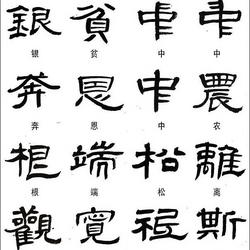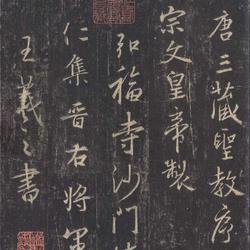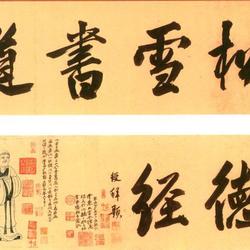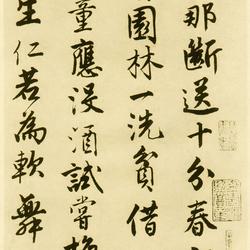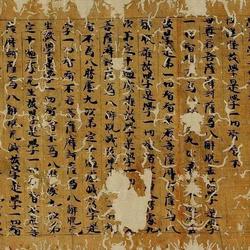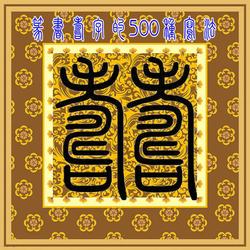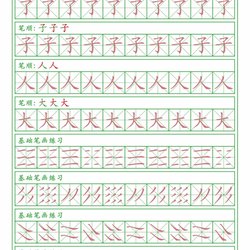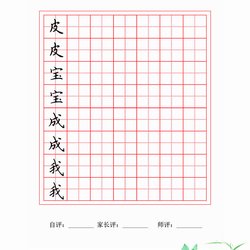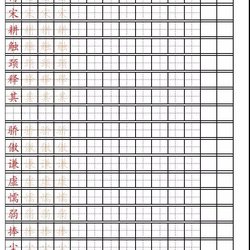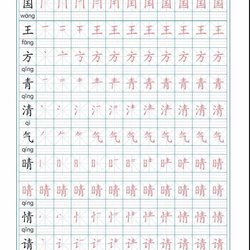Huai Su's "Autobiography"ofAppreciation and copywriting
Huaisu (AD 737-799) was named Zangzhen and his common surname was Qian (one day his common surname was Fan). A native of Yongzhou, Hunan, he was a famous calligrapher in the Tang Dynasty. Together with Zhang Xu, a calligrapher of the same generation, they are regarded as the two peaks of Kuang cursive calligraphy in the history of Chinese calligraphy, and are known as "Bian Zhang Kuang Su" in the world. Huaisu came from a poor family when he was young and became a monk at the age of ten. He was obsessed with calligraphy, especially cursive calligraphy, and was extremely diligent. According to legend, because his family was poor and had no money to buy paper, he planted bananas extensively and used banana leaves instead of paper to practice calligraphy. The residence number is "Lvtian'an". I also painted a tray to practice calligraphy, and wrote through the bottom of the tray. The bald pens turned into mounds, and the water in the pen-washing pool was completely black. He likes to drink alcohol and does not stick to trivial matters. When he is in a mood, he writes on all the walls, screens, clothes and utensils of the temple. When he was twenty-two years old, he met Li Bai, who was pardoned on his way to exile as Yelang. Li also admired Huai Su's talent in cursive writing and wrote "Songs in Cursive Script" as a gift to Huai Su. It can be seen that Huaisu's cursive writing skills at that time were already well-known in Xiaoxiang. In the first year of Baoying of the Tang Dynasty (762), Huaisu left the temple and traveled far away, visiting the wise men of the time, paying homage to famous officials, and reading all the dharma texts of the past dynasties. Passing through Hengyang, he went to Guangzhou and met with the great calligrapher Xu Hao. In the year he was established, he lived in Changsha, and the following year he left Chang'an westward. Idle clouds and wild cranes travel around the world, broaden their horizons, and improve their calligraphy skills. He first learned calligraphy from Ouyang Xun, and was appreciated and supported by Wei Zhi and Xu Hao. Later, he sought advice from Zhang Xu's disciple Wu Tong and the great calligrapher Yan Zhenqing. The person who had the greatest impact on him was Zhang Xu. The wild cursive calligraphy uses twists, turns, swings and intersperses, like a sudden rain and whirlwind, whirling and moving, which means that he learned from Zhang Xu and came out of his own mind. People in the past called it "the madness that leads to madness" and "the madness that leads to madness". In 777 AD, at the age of forty, Huai Su wrote the shocking "Autobiography", which established his lofty status as the "Cao Sage" in the history of Chinese calligraphy.
The scroll of "Autobiography" is 28.3 cm in length and 755 cm in width, and is made up of 15 pieces of white linen paper. A total of 126 lines and 695 words. This short self-promotional article by Huai Su can be divided into three parts:
In the first part, Huaisu briefly describes his life in more than 80 words;
The second part is an excerpt from Yan Zhenqing's "Preface to Master Huaisu's Songs in Cursive Script", with more than 250 words, borrowing from Yan Lugong's words to show that "Huaisu is the most outstanding scholar. "Grass Saint" weather;
In the third part, Huaisu extracted the essence of the poems donated by eight people, including Zhang Wei, Yu Xiang, Zhu Kui, Li Zhou, Xu Xi, Dai Shulun, Dou Ji, and Qian Qi, and divided them into "describing similar shapes" and "describing similar shapes" according to their content. The four aspects of "narrative style", "quick speech" and "foolish eyes" are listed here. The author uses about 70 words such as "running snakes and flying dragons", "sudden rains and whirlwinds", "strong men pulling out mountains and stretching strong iron", "like mountains opening thousands of peaks", etc. to vividly describe its wild and wild appearance. Beautiful form. The so-called "machine grid". It refers to the creative method, with more than a hundred words used, such as "continuing the peak with madness", "aiming for novelty without fixed rules", "awakening but unable to write". In particular, the sentence "Wujun Zhang Dian never met" should be an unprecedented hymn to the super-talented Zhang Xu. The so-called "quickness" refers to the speed of his writing. He quoted more than 40 words, including "the whole house was speechless", which is a very vivid description of "quickness". The so-called "foolish" words are mostly modest words. Quote: "When you are crazy, you will underestimate the world, but when you are drunk, you will see the truth." For Huaisu, how can "madness" and "drunkness" mean "foolishness"?! At the end of the article, Huaisu is worried that people will say that he is borrowing the same name. Gongzhi praised himself and wrote a special sentence: "It is not something that a weak person dares to take on. It will only increase his shame and fear." No matter how he explains it, his leisurely and self-proclaimed emotional expression comes across clearly on the page. The whole article vividly interprets the charm of Huaisu's Kuangcao art, and it can be called an eternal masterpiece of Kuangcao calligraphy criticism.
Next, let’s take a look at the artistic features of the calligraphy of “Self-narrative Tie”.
Cursive script sprouted from sloppy official script. "Shu Pin" says: "The momentum started in the Han Dynasty, when the official script was disbanded. It was used to deal with emergencies." It is said that the "Weapons Book for the Fifth Year of Yongyuan" written by Emperor He of the Eastern Han Dynasty is the quick version of the official script - Zhangcao style. By omitting strokes and linking lines, official script has become much faster to write. After artistic processing, it has gradually developed into a calligraphy style that often ends with an upturned tail like a wild goose. It's called "Zhangcao". Since the emergence of regular script in the Wei and Jin Dynasties, cursive script has been developed into "Jincao" based on Zhangcao and combined with the emerging regular script. Today in the grass. If each word is independent, it is called a small grass or a single grass, as is the case in Zhiyong's "Thousand-Character Essay in Cursive Script". By the middle of the Tang Dynasty, Zhang Xu was making cursive paintings. His strokes were simple and simple, and the words were connected and even one line at a time, which was expressive and elegant. Huai Suji's writing style became more rapid and unrestrained, and the upper and lower characters ran through it in one continuous flow. Later generations called this kind of calligraphy "big grass" or "crazy grass". Huaisu's "Autobiography" is recognized by the world as a masterpiece of cursive calligraphy. The artistic characteristics of "Zi Xu Tie" have actually been vividly laid out in the original text of "Xu", with the help of the words of the wise and famous people of the time. Its artistic power of classical romanticism is intoxicating, as has been introduced in the previous article. Below I will make some further analysis on its writing style, structure, and composition. Let’s look at his pen first. Zhang Xu used the pen to draw from the official script. Therefore, it is folded in many directions; Huai Su changed it to his teacher and inherited the seal script. Because of its multi-circular shape, he is especially good at twisting and winding brushwork, vertical and horizontal twists and turns, multiple directions, both tight and tight, and the loops are strong and vigorous. For example, the word "Ji Qie" in line 118 and the word "solid but not virtual" in line 120 are round, straight and flexed like a steel wire. Although they are thin, they are solid and plump, creating a new look of cursive calligraphy. Liu Xizai, a calligraphy critic in the late Qing Dynasty, once said:
"Those who are good at writing are quick and prepared." Huaisu's brush flips and jumps, varying with the situation, and he has indeed reached a state of perfection. Let’s talk about structure next. Compared with Erwang and Zhiyong, the structure of Huaisu's cursive script has many inheritances. There are many identical characters in the text, and the knots are all similar. Due to the excessive speed of writing, a few numbers do not completely follow the conventional principles of conciseness.
The "stupid drawing" cannot be avoided if there is no explanation. Some words are indeed difficult to identify, such as "sui" in line 31, "ju" in line 47, "ang" and "jiao" in line 48, "ying" in line 50, "倪(anger)" in line 51, 79 The words "fear" in line 91 and "awake" in line 91. That's the example. Looking at Tong Fa again, the whole work is so novel in composition and style that it has never been seen before. In the first two-thirds of the article, the author is calm and composed, and his writing moves smoothly and smoothly. It is free and easy, showing the simple, transparent, fast and smart temperament of Kuang cursive calligraphy. When I reached the 12th piece of white linen paper and the 105th line of the word "Dai Gong", the word "Dai" suddenly grew out of proportion, occupying three and a half lines of the previous text horizontally and four to five characters long vertically.
The character "公" is written smaller and flatter than ordinary characters, creating a strong visual impact. It may be that Huaisu was under the influence of alcohol and reached the peak of emotional excitement. By the last 10 rows, there were no rows or columns, the streets were paved with rubble, and the goddesses were scattering flowers as they pleased. The image of the drunken monk who "crazyly comes to despise the world" emerges vividly on the page. It brings readers into an ecstatic state of art. Using the "three-meter character grid" to conduct a planar analysis of each row, it was found that there are 52 rows that are vertical, 63 rows that are straight at the top and tilted to the right at the bottom, and only 4 rows that are straight at the top and tilted to the left at the bottom. 119 of the 126 lines are written with numbers in one stroke, or even one line with each stroke, while only 7 lines are filled with a single cursive character. From this, we can draw a standard for dividing Kuangcao and Jincao, which is the difference between characters and cursive characters. The words and strokes are connected, and it is proposed that the study of Kuang cursive calligraphy should be based on "line", breaking the past convention of studying calligraphy, whether it is real cursive calligraphy, on the basis of a single character. Based on this theory, a patented product for cursive classic appreciation and pro-writing was designed with three-meter grid lines. This book of Huaisu's "Autobiography" printed in three-meter grid provides readers, especially friends who practice cursive calligraphy, with a tool to interpret classics in a new way. The art of cursive calligraphy is the calligraphy style that best displays the charm of Chinese calligraphy art, and is also the art form most likely to blend with modern art. It not only satisfies the aesthetic needs of traditional culture, but also coincides with the mainstream elements of fashion culture, allowing calligraphy enthusiasts to draw nourishment from the appreciation and copywriting of Kuang cursive calligraphy classics. Finding creative inspiration should be the only way to learn calligraphy.

